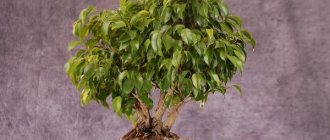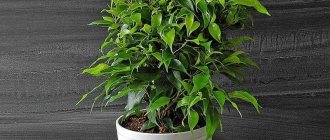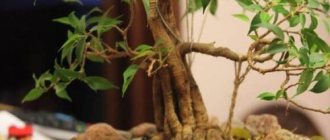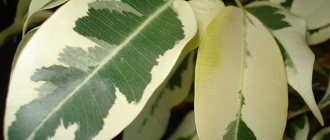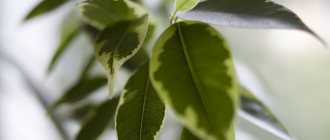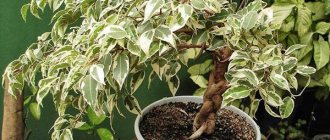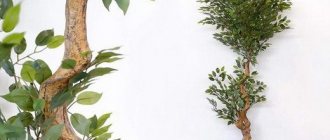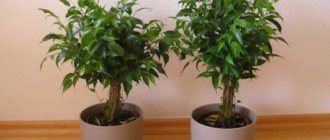Ficus benjamina is rightfully considered one of the most common indoor plants. And this is not without reason, because ficus has high decorative qualities and is able to delight its owners with rich green foliage all year round. However, its cultivation is a very labor-intensive process, especially in the first few months, but having learned all the subtleties and nuances of caring for ficus, this process becomes easy and uncomplicated.
Ficus Benjamin is an evergreen tree, a shrub of the Mulberry genus, whose homeland is located in the subtropics and tropics of India, China, southeast Asia, and even Australia and the Philippines. The house plant is a small tree with a short trunk, gray-beige smooth bark, and chiseled leaves with an oblong oval shape pointed at the top.
Description
Since ancient times, Australia has been considered the ancestral home of the ficus; today, the ficus has actively spread throughout America, Africa, Asia and India. In Russia it is found on the Black Sea coast and in the Krasnodar region. An evergreen tree or shrub that grows up to 25 m in height in the wild.
Ficus benjamina
Ficus Benjamina, one of the most popular species of evergreen plants. The indoor tree has medium-sized emerald foliage and an erect trunk, sometimes taking on a bizarre shape, in the form of an interweaving of several large shoots, cascading branches, and a bright green lush crown.
The leaf of Ficus Benjamin is smooth, pointed, elliptical in shape, richly green in color or with variegated patches. On average, a ficus leaf grows to 8-9 cm. The branches are flexible, covered with gray, thin bark. With proper care, the plant reaches one and a half meters in height.
A special feature of Ficus Benjamin is its capricious nature.
A tree can easily shed its leaves for no apparent reason, due to the slightest lack of nutrients in the soil, or due to climate change in the room. However, you should not be upset, and “the devil is not as terrible as he is painted,” a couple of fertilizing is enough and the tree will turn green again.
Features of the plant
Ficus Daniel has the form of a bush. A large number of flexible, densely growing lateral branches extend to the sides from the vertically growing stem. The leaves of the tree have an elongated shape with a pointed end and a glossy surface. The size of an “adult” leaf is about 5 cm. Young leaves are light green in color and darken over time. Thanks to proper formation, the plant can be given any shape (flexible branches can be braided, curled in spirals, etc.), which makes Danielle a wonderful decoration for any interior.
Since the homeland of ficus Daniel is the tropical zones of West Africa, Asia and Australia, for the active growth and development of the plant it is important to create conditions close to tropical. Otherwise, the tree will not be able to delight you with juicy, green leaves and an ever-growing crown.
Popular ficus varieties
There are several varieties of Ficus Benjamin, each of them has a special appearance.
Variety Exotic
Exotic
This is a compact and unpretentious plant with dark green leaves with wavy edges. It is recommended to start getting acquainted with Ficus Benjamin with this variety due to its unpretentiousness.
Variety Danielle
Daniel
Very similar to the exotic variety. Its leaves are quite large (6 cm) and dark green.
Variety Monique
Golden Monique
A very common variety, which is divided into two similar types: simply Monique and Golden Monique, the leaves of which are characterized by a golden hue. This variety is more capricious than Daniel and Exotica.
Variety Reginald
Reginald
This is the most popular variety and is highly valued for its variegated leaf color. Small light green spots are randomly scattered on a light green background. The edges of the leaves are smooth, not wavy.
Variety Kinkye
Kinky
The color of the leaves is characterized by a combination of a dark green background and a light green edging. The leaves are quite small, not exceeding 5 cm. It is this variety that often needs pruning and shaping. You can create a fancy figure from it.
Variety Nicole
Nicole
Winner for uniqueness of pattern. The light green edging here is much wider than Kinki's. This contrast of dark and light shades looks attractive.
Variety Starlight
Starlight
The leaves of this plant are almost completely white, it looks very impressive. Due to a lack of chlorophyll, the plant needs intense lighting.
Barok variety
Baroque
Its small leaves curl in a funny way, which gives the plant a very unusual appearance.
Among this variety, it is not easy to choose exactly the ficus Benjamin variety that will become your new best friend. It is recommended to prepare for the purchase, learn as much as possible about the characteristics and requirements of the type you like in appearance. A healthy and happy ficus will not only decorate the room, but also purify the air, filling it with useful substances!
How to care for ficus benjamina
In order for this plant to be healthy, pleased with its glossy leaves and grow quickly, it is necessary to follow some rules of care.
Lighting
Ficus benjamina loves bright, diffused lighting; it looks best on western and eastern windows. If possible, take the plant outside or onto the balcony during spring/summer. Fresh air and plenty of light will definitely benefit the ficus. It will fluff up and accelerate its growth. However, it is better to shade it from direct sunlight, otherwise burns will appear on the leaves.
The variegated (variegated) varieties of Ficus Benjamin are especially demanding when it comes to lighting. With a lack of light, they lose their originality, their foliage becomes ordinary, green.
A caveat should be made here. Ficus benjamina can tolerate poor lighting for some time. That is, it can easily stand in your place somewhere in a dark corner for several months. It will not die, but some of the leaves will lose and their color will become dull. That is, as a necessary measure, temporarily, you can place the ficus in a place with insufficient lighting. But it cannot be placed there on a permanent basis.
Temperature
Ideal temperatures for Ficus Benjamin are 16-24° C. But deviations from this range by 4-5 degrees in one direction or another will not cause any particular harm. Try not to let the temperature drop below 10° C, otherwise the ficus will most likely begin to lose leaves. Not necessarily though. If your plant is acclimatized and hardened, then there may not be any negative effects even if the temperature drops to 5° C.
Note! In winter, protect Ficus Benjamin from drafts. Make sure that it does not blow from an open window if it is frosty outside. Almost certainly, after frostbite, the ficus will drop all its leaves. And it will grow them again only in the spring. Best case scenario. At worst, the plant may die.
Watering and humidity
It is necessary to water Ficus Benjamina at home sparingly, since excessive soil moisture often leads to rotting of the root system. Between waterings, the soil in the pot should dry out by 1-2 cm. In winter, more drastic drying can be allowed.
For irrigation, use only warm, settled or boiled water. And this is a very important condition. Ficus benjamina is very sensitive to chemical impurities that tap water contains, such as chlorine and fluoride. Therefore, it is necessary to either settle the irrigation water (at least 8 hours) or boil it.
Spraying
Another important parameter for the health of Ficus Benjamin is high air humidity. In summer and when central heating is on, regularly spray its leaves with warm water. In autumn, on cold days, when the heating is not working or is not turned on at full power, spraying should be avoided.
Note! In winter, do not place Ficus Benjamin near radiators. Too dry air causes leaves to fall.
Top dressing
In the spring-summer period (from March to September inclusive), the Benjamin ficus enters a phase of active growth: foliage grows and young shoots appear. All this requires nutrition, which may not be enough in the soil. Therefore, to ensure full development of the ficus at this time, feed it with fertilizer with a high nitrogen content every 1-2 weeks. In stores, such fertilizers are usually sold with the note “for decorative deciduous plants.” There are also fertilizers specially designed for ficus, for example, Agricola - “For ficus” with a ratio of 23:10:16 (N:P:K).
Note! Root fertilizers are applied in moist soil. That is, first you water the plant with clean, settled water, and after 15-20 minutes - with water with diluted fertilizer. This approach will reduce the risk of chemical burns to the roots.
In autumn and winter, Ficus Benjamin, growing at home, does not need to be fed, since all vital processes slow down during this period. The plants enter a resting stage.
Caring for Ficus Benjamin at home
Location and lighting
Ficus benjamina needs good lighting, but direct exposure to the sun is contraindicated for it. The best option is bright diffused light. It is better to place the plant on western or eastern windows. On the south side it is necessary to shade the plant. But on the north side, the ficus may not have enough lighting.
Temperature
The optimal temperature in summer is 18-23 degrees, in winter the temperature should not fall below 16 degrees. Although Ficus Benjamin tolerates wintering quite well at standard room temperatures.
Fresh air is what the plant also needs. Having protected from the wind, the tree can be taken out to the balcony or placed on a windowsill on the street side. The most important thing is to protect the plant from bokweeds; ficus plants cannot tolerate them.
Watering
Ficus benjamina requires a lot of water, especially in summer during the period of active growth, so in no case allow the soil to dry out. In autumn and winter, watering should be reduced, doing it sufficiently only once a week.
If you often forget to water the plant or water it insufficiently, the ficus, as if in revenge, immediately sheds its leaves. But still, it is best to adhere to a reasonable balance when watering the plant.
Air humidity
Throughout the year, Ficus Benjamin needs constant spraying of the leaves. In summer you can spray the plant at least every day; in winter you need to do this much less often. Sometimes the ficus should be washed in the shower - this promotes the healthy development of the plant, as well as good prevention against pests such as spider mites and scale insects.
The soil
The substrate for growing Ficus Benjamin should be well-drained, slightly acidic or neutral. You can make it yourself from deciduous, turf soil, coarse sand and peat with the addition of small pieces of charcoal in a ratio of 2:2:1:1. Or you can buy ready-made soil mixture for ficus.
Feeding and fertilizers
Having survived the winter, in the spring-summer period, the ficus becomes a little lethargic and especially needs nourishment. By feeding your indoor tree with complex mineral fertilizer every two weeks, you can quickly revive it.
Transfer
The time will inevitably come when the young ficus becomes cramped and will need to be replanted. The best time to transplant Ficus Benjamin is spring. Young ficuses need to be replanted every year, adult plants - once every 1-2 years. To create a comfortable living environment for an adult tree, it will be enough to renew the top layer of soil.
Trimming
In order for the trunk to acquire thickness and texture, experienced florists plant 2-3 plants together and weave their trunks into a plait or braid, which over time takes on the appearance of beautiful hummocky growths.
If you are a beginner gardener, it is better to start by practicing pruning young Benjamin. To do this, on well-branched leaves you need to cut off the top with 2-3 buds, and to maintain a beautiful shape, repeat the procedure every 3-4 years, sprinkling the cuts with charcoal to prevent the milky liquid from leaking out.
How to prune ficus benjamina
An important component of ficus care is its pruning. The growth rate of young shoots and branches is high; without pruning, the tree takes on a sloppy appearance, stretches upward and does not bush. Pruning is carried out in early spring, and in summer they only regulate the growth rate of individual shoots that stand out from the general mass.
Pruning allows you not only to control the development of the plant, but also to establish important air exchange in the crown of the tree, eliminate diseased or damaged parts, and prevent pest attacks and the development of diseases.
The branches are cut with sharp pruning shears, without cutting off more than 35% of the ficus crown at a time, otherwise the plant may get sick. In addition, large sections should be sprinkled with ash or crushed coal.
In most cases, the ficus is given the shape of an upright tree with a lush cap, but if desired, the plant can be given an extraordinary, bizarre shape; for this it is necessary to intertwine the trunks of several young plants and carefully secure them with plastic clamps, without interfering with the development of parallel trunks. As they grow, the trees will change, acquiring an unusual wicker shape of a single trunk, and after a few years they will completely grow together.
To ensure that the tree takes on even more fun shapes when pruning, we recommend watching a video on turning a ficus into a bonsai and being patient.
Ficus benjamina: transplant
It is best to transplant Ficus Benjamin at home in March or April. Young specimens need replanting annually, and adults – once every three to four years. In between, remove the top layer of substrate from the pot and replace it with fresh one.
Replant your ficus as follows:
- Take the flower out of the old pot with a lump of earth and, using the transfer method, place it in the center of the new pot, where a layer of drainage and a layer of new substrate have already been laid.
- Fill the voids between the plant and the walls of the pot with soil, shaking the pot slightly. If the room is hot, lightly water the transplanted ficus and spray its crown with a fine spray bottle.
- If the room is cool, it is better not to water the transplanted plant for a couple of days.
- Young Ficus Benjamin bushes should be checked frequently for rapid root growth. To do this, turn the pot over and look at its bottom.
The roots may already be peeking out of the drainage holes. If so, rejoice, you got a fast-growing specimen. Without waiting until next spring, you will have to transplant it into a new, slightly larger pot.
Ficus pot
Choose a clay or ceramic pot for ficus benjamina. The new pot should not be too bulky, just a little larger than the old one. Then the root system of the flower will quickly cope with the development of the entire volume of new soil, and the flower will more easily take root in the new place. Let us immediately pay attention to the size of the pot for creating ficus bonsai - it should be wide and shallow.
What kind of soil should it be?
The natural habitat of Ficus Benjamin is the humid tropics with their characteristic moisture-absorbing nutritious soil.
When growing indoors, you need to buy or prepare a substrate yourself that is similar to its natural composition.
For Ficus Benjamin, purchased soil for decorative foliage plants is suitable. You can use the soil for Mulberry plants or Palm trees.
Note that ficus plants are not very picky about the composition of the soil. It is only important that it is nutritious, breathable and has neutral acidity.
Self-prepared soil should be like this: a mixture of peat, garden soil and sand in equal parts. You can add a little wood ash to eliminate the acidity of the soil. Adult specimens require a denser substrate, so turf soil and humus should be added to this soil composition.
Do not forget! At the bottom of the pot there should be a good layer of expanded clay or other drainage material with the addition of pieces of charcoal.
Description of the plant
Ficus is a houseplant from the Mulberry family, which also includes mulberries and figs. Growing it at home is almost always successful, but in some situations it can be a little capricious. It is enough to know exactly the requirements of the plant and provide it with the necessary conditions so that it will charm us with its unique leaves and beautiful shape.
Ficus Benjamin or Benjamin (Ficus benjamina) is the most popular representative of the genus Ficus. This unusual ornamental plant is characterized by slow growth and small, very decorative leaves. In nature, it can be found in Asia and Australia, where the species is a tall, powerful tree, reaching a height of 25 meters, its branches descending downwards.
Photo. Ficus benjamina in its natural habitat
Interesting fact. In English, Ficus benjamina is called weeping fig, which means weeping fig.
In our country, it is grown exclusively at home, since the plant is very heat-loving and does not tolerate cold. It is rarely put on the balcony; it is impossible to grow it in the garden. Usually it is bought in the form of a small seedling. In a pot it grows from 30 cm to 2.5 m in height. Varieties of small-leaved ficus can reach a height of 5 meters. There are cases where a plant slowed down its development when its leaves began to touch the ceiling. There are also numerous dwarf varieties that can be shaped like a bonsai tree.
Attention! Ficus is one of the main sources of indoor allergens! It is considered the third leading cause of allergies, after dust and pets. This is a toxic plant for pets - dogs, cats.
This type of ficus is especially decorative with leaves - they have a dark green color, a light, white or yellow border. The leaf plates have an elliptical shape, length - from several to several tens of centimeters. On erect shoots, the leaves appear densely and are arranged alternately. Sometimes ficus forms hanging shoots, which increases the attractiveness of the plant.
The plant can bear fruit in the summer, but very rarely; tiny orange-red fruits appear.
How to propagate ficus benjamina
There are three options for propagating this plant.
Propagation by cuttings
- For these purposes, they usually take a semi-lignified cutting, not too young, but not very mature either. It is cut with a sharp knife, and does not come off.
- The milky juice that appears on the cut must be washed off.
- To speed up the appearance of roots, it is recommended to cut the base of the cutting.
- The cutting takes root successfully in water, usually in 1-2 weeks.
- To create a greenhouse effect, a larger glass jar is sometimes placed above the jar with the cuttings.
- When the roots have appeared, the cutting is planted in the soil and covered with polyethylene.
Ficus benjamina cuttings
Reproduction by layering
To obtain layering, a ring-shaped cut is made on the lignified stem, then the bark is removed and this area is wrapped with damp sphagnum moss and polyethylene on top. Over time, roots will appear through this coating. Then the top is cut off and placed in prepared soil.
Growing ficus benjamina from seeds
Some gardeners soak the seeds in water for 1 day before planting, but this procedure is not necessary. Seeds are sown in moist soil consisting of sand and peat. They need to be evenly distributed over the surface and immersed 0.5 cm. To ensure heating, the container with the seeds is placed on the radiator if it is heating up. It is necessary to regularly ventilate and spray the seeds. After 1-2 months, the seeds produce their first shoots.
Among all these methods, the easiest and most effective is propagation by cuttings.
When and how to prune?
Ficus Benjamin Daniel grows quite quickly. After pruning, the tree easily forms new shoots in place of the removed ones. Therefore, if properly cared for, the ficus will quickly produce a plant of the desired shape. During pruning, the plant secretes a milky sap, which is washed off immediately after it appears. It is advisable to trim excess shoots in early spring, during the period of intensive growth of the ficus.
From Daniel's flexible branches you can form a crown of any shape by planting 2-4 plants nearby. Ficus is also ideal for forming a crown of sculptural forms.
By properly caring for your ficus Daniel, you can decorate your home not just with a green tree, but with an original living sculpture made of fresh, succulent leaves!
Diseases and pests
When growing Ficus Benjamin, the following problems may arise:
- The lower leaves fall off. Sometimes this is a natural process as the ficus matures, and sometimes it is a sign of hypothermia and insufficient lighting.
- Ficus benjamina leaves wither and curl. The plant is cold and suffers from low temperatures.
- The tips of the leaves turn brown. The humidity level is very low and the indoor air is dry.
- New shoots are thin. The plant lacks lighting and nutrition.
- The leaves of Ficus Benjamin are turning yellow. The plant is subjected to too intense watering, its root system begins to rot.
- The leaves are soft. Another sign of flower hypothermia.
- Yellow and brown spots on leaves. This is how sunburn appears on the surface of the leaves. The plant is exposed to excessive solar radiation.
Spots on ficus benjamina
Ficus can also become a victim of the following pests:
- mealybug;
- scale insect;
- spider mite
- White lumps at the base of the leaves may indicate a mealybug problem. This pest has a small body, as if covered with cotton wool. How to deal with mealybugs on Ficus benjamina: Remove white spots on the leaves of Ficus benjamina using a soft sponge soaked in a soapy solution. Treat all parts of the plant with soapy water. Treat with insecticide. After this, you can trim the bush, and when it is completely restored, then spray it with epin or succinic acid.
- Sticky leaves indicate a scale infestation. A related problem may be sooty fungus, which is very fond of the sweet secretions of this pest. The infected plant is washed with soapy water and treated with Actellik.
- Spider mites on Ficus benjamina appear in dry indoor air. The infected plant does not grow, begins to wither, turns yellow and drops its leaves. The first thing to do when you find cobwebs on your Ficus benjamina is to increase the humidity in the room. To do this, install a humidifier, vessels with water nearby, or sprinkle with water mist. Spraying with a soap solution, Aktara or Aktellik will help get rid of pest colonies. Afterwards, the bush is covered with a transparent cap or bag and ventilated daily.
Ficus benjamina leaves are falling: what to do
Ficus benjamina sheds its leaves for various reasons such as:
- sudden changes in temperature;
- drafts;
- low humidity levels;
- excessive or insufficient watering;
- low air temperature;
- insufficient fertilizers;
- change of location;
- watering with cold water;
- insufficient lighting.
If the tree is healthy, after eliminating the main cause that caused the leaves to fall, they begin to grow back immediately.
What to do if all the leaves have fallen off?
If this does happen, the following actions must be taken: eliminate all negative factors in the room that have a detrimental effect on the ficus.
- Check the temperature and humidity.
- Eliminate drafts and nearby heat sources.
- Do not move the pot with the plant.
- Check the soil and plant roots.
- Make sure there is sufficient lighting level.
Watering and humidity
Before watering the plant, the water must be allowed to stand, and before watering, check that the liquid is not hot or too cold. The best option is water at room temperature. On hot summer days, water the flower 1-2 times a week. In winter, the frequency is reduced to once a week or once every 2 weeks. Watering the ficus is done as needed to prevent the roots from drying out.
Important! If excess moisture accumulates in the pan, it must be drained to prevent root rot.
Throughout the year, it is recommended to spray the ficus crown with water at room temperature. A warm shower about once a month is also helpful. Such procedures will help maintain a sufficient level of humidity, which Daniel needs to maintain the color and juicy appearance of the leaves.
Ficus Benjamin: signs and superstitions
There are many superstitions associated with Ficus Benjamin. If in the East this plant is considered to be a symbol of wealth and prosperity, then in Russia and the CIS countries the ficus is called “muzhegon” and is credited with magical properties that have a negative impact on family members.
In China, Ficus Benjamin is given as a wedding gift and passed on from one generation to another, and in some Eastern countries this beautiful tree is considered sacred. At home, ficus is able to absorb negative energy, attract wealth into the house and help in amorous matters. If you give Ficus Benjamin to a childless couple, they will soon have a child.
But in order for this tree to have a positive effect on the “weather in the house”, it must be placed correctly:
- Kitchen - wealth and relief from financial problems.
- Office - good luck at work and increased productivity.
- Bedroom – improved sleep, relief from anxiety and quick pregnancy.
You should not place a pot of Ficus benjamina on the north or west side of the house. Then the plant will not have enough sun, and it will not be able to influence the microclimate in the family.
Everyone decides for himself whether to believe or not to believe in various superstitions. But in any case, if this beautiful and lush tree appears in the house, the room immediately transforms and becomes more comfortable.
Interesting Facts
- Ficus benjamina is the symbol tree of Bangkok, the capital of Thailand.
- Often, to give thickness and texture to the trunk of a plant when grown for decorative purposes, 2-3 plants are planted together and their trunks are woven into a braid or strand. As they grow, the trunks grow together and form beautiful growths.
- In the Royal Botanical Gardens in Peradeniya, Sri Lanka, there is a ficus tree that is 150 years old and has a crown area of 25 square meters. Local residents gave it the name “Turtle” due to the similarity of the crown shape with this animal
Sources and literature
